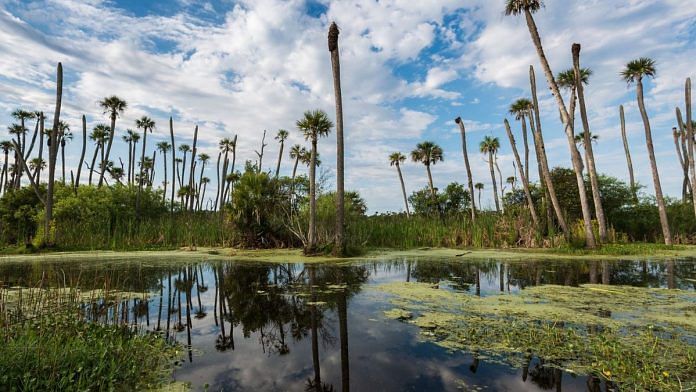New Delhi: In 2020, the year Covid-19 pandemic led to global economic slowdown, researchers documented an alarming rise in atmospheric level of methane emissions, despite a drop in human-induced emissions.
Scientists attributed the methane growth rate anomaly to lower hydroxyl radical (OH), which is the main remover of methane, and higher natural emissions, mostly from wetlands.
The observations were published in the Nature journal Wednesday in an article titled ‘Wetland emission and atmospheric sink changes explain methane growth in 2020’.
Methane is a greenhouse gas 25 times more potent than carbon dioxide at trapping heat in the atmosphere, making it a bulking agent for global-warming. Scientists are now concluding that this was due to warm, wet weather in the northern hemisphere and, a slowdown in air-pollutant emissions.
Analysis showed the annual increase in methane for 2020 was 14.7 parts per billion, the largest yearly increase recorded since systematic measurements began in 1983.
The study noted that, globally, total methane emissions linked to human activities (anthropogenic) and fire decreased while wetland emissions shot up. However, the increase in wetland discharge was mainly located in the northern hemisphere, whereas the decrease in fire emissions was mainly in southern tropical regions.
“Our results imply that wetland methane emissions are sensitive to a warmer and wetter climate and could act as a positive feedback mechanism in the future,” the study stated.
A tale of two methods – assessing methane sinks & atmospheric model
In order to understand the atmospheric rise in 2020, in comparison to 2019, scientists studied major sources of methane emissions – wetlands, freshwater areas, fires, landfills and fossil fuel extractions. They then used a combination of two methods, assessing emissions by way of sources (methane sinks – elements which consume methane from the atmosphere) and a more top-down approach, using a model that simulates the chemistry and physics of the atmosphere.
The former proved that wetland emissions saw a steep rise due to “unusually warm and wet weather in the northern hemisphere, especially in the Arctic, despite emissions due to fires dropping in 2020”.
Natural wetlands emit approximately 30 per cent of global methane, with water logged soil perpetuating production of the gas. Methane is emitted in low-oxygen environments – through the decomposition of organic matter. The marshy terrain of wetlands enables an oxygen-deficit, thus generating methane. Emissions from other natural sources like freshwater and melting permafrost remained relatively unchanged.
In 2020, the northern hemisphere was hit with its hottest summer yet. The Arctic region, seen as an indicator for temperature changes across the world, witnessed a massive decline in sea ice.
The second model accounted for the lower-than-normal emissions from fires and the reduced release of fossil fuels.
“The reduced combustion of carbon fuels and lower fire emissions also caused less carbon monoxide (CO) and nitrogen oxides (NOx) to be released to the atmosphere during the first half of 2020. Both CO and NOx affect the atmospheric concentration of the hydroxyl radical (OH), which is the main sink of methane. Even a small change in OH has a large impact on the methane growth rate,” the study underlined.
Hydroxyl radical is called the detergent of the atmosphere, and works to reduce methane levels. Its reduced quantities led to more atmospheric methane in 2020.
The dual approach sheds light upon two major contributors – changes in natural sources and atmospheric shifts.
India’s methane emissions
Over the last two centuries, methane concentrations in the atmosphere have more than doubled, largely due to human activities. The potent greenhouse gas has more than 80 times the warming power of carbon dioxide. Though methane lingers for only 12 years as compared to carbon dioxide that remains in the atmosphere, it absorbs more energy.
As of now, 60% of methane emissions are anthropogenic emissions, mostly from the agriculture, farming, and energy sector. At this year’s Conference of the Parties (COP) over 150 countries signed a global pact to slice methane emissions by 30 per cent.
A methane cut-down is seen as vital to ensuring adherence to the Paris Agreement, which came into effect in 2016, according to which global heating needs to be capped 1.5 degrees above pre-industrial levels.
India did not sign this pact, despite being the world’s fourth highest methane emitter. India has previously stated that it plans to utilise methane as a source of energy.
Methane alone constitutes approximately 29 per cent of total greenhouse gas emission in India as opposed to the global average of 18 per cent. According to one estimate, India’s total methane emissions are in the range of 669 million tonnes of C02 equivalent (MtCO2E), researchers Shyamala Mani and Pooja Ghosh had said in Deccan Herald.
Though India is considered a force to be reckoned with in the shift to renewables in order to mitigate climate change, its approach has been tentative when it comes to what has been called its “methane problem.”
Also read: Two atoms, 192 lasers- how US scientists harnessed Sun-like fusion power for 1st time on Earth



